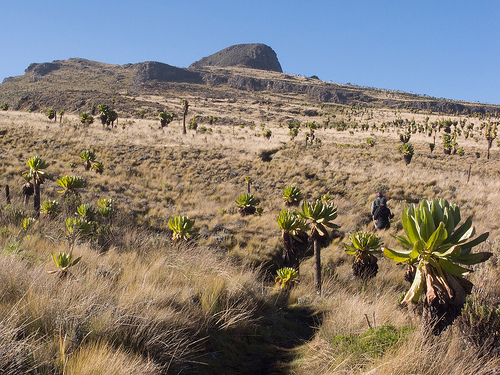

Location: Map
Height: 14,138 ft (4,300 m)
Mount Elgon National Park is a protected area in the Eastern Uganda on the border with Kenya. Mount Elgon National Park covers an area of 4,138 ft (4,300 m) and named after mount Elgon, an extinct volcano, that stands in the park. Area of Mount Elgon National Park is most famous for its 'Elephant caves' that inspired many stories including a novel 'King Solomon's Mines'. Mount Elgon National Park lies on the border between Uganda and Kenya around extinct volcano Mount Elgon. Elgon first erupted 24 millions years ago and over a course of its activity it spewed lava that covered an area of 50 to 80 kilometers. Today this area is very popular with hikers. Most popular time to come here is during drier season between June to August and December to March. Some visitors prefer lodges and hotels in the nearby settlements, but Mount Elgon National Park does offer five basic (very basic) campsites around perimeter of its borders.
Mount Elgon National Park has numerous attractions and notable destinations. This include spectacular views, hot water springs where water can reach 48 C and many others. However Mount Elgon National Park is most famous for so called Elephant Caves. These natural formations were formed in the ancient deposits of salt from a evaporated sea. Original natural erosions were further increased by the herds of wild animals, most notably elephants that came here in search of salt. They licked salt deposits thus further adding to the erosion of the caves.
Kitum Cave
Kitum Cave is one of the largest of the so called "Elephant caves" situated in Mount Elgon National Park. It extends for over 200 meters (700 feet) below ground. Kitum Cave became famous in the 1980's when two European visitors contracted deadly Marburg virus presumably from bats that lived within depths of this natural formation. Both people died from a virus. In September 2007 scientific expeditions were undertaken in the area of Mount Elgon National Park and its surroundings. They found evidence that suggested that cave dwelling species of bats (Egyptian fruit bats) and their guano (excrement) were in fact reservoirs for the deadly virus. Apparently tourists inhaled particles left by these animals that allowed further colonization of unsuspected hosts. So keep this in mind as you choose to explore these destinations.
Criticism
When it was founded, around 30,000 Sabiny (an ethnic
group from this region) were forcibly resettled in the so-called Benet
resettlement area. The first shipment from the national park area to
this resettlement area took place in 1983 and was only "partially
successful" - a considerable part of the Sabiny evaded resettlement and
remained in the national park. The government only made the bare land
available to the resettled people. They were not offered start-up aid
such as building materials, agricultural equipment, seeds or the like. A
second wave of resettlement occurred in 1992, when people were forced at
gunpoint to leave the national park. In the course of this punitive
action, people were beaten, there were numerous physical injuries and
rapes, the Sabiny's cattle were slaughtered, their houses were set on
fire. But that's not all: In the course of this displacement, the size
of the resettlement area made available in 1983 was reviewed by the
Uganda Wildlife Authority (UWA) and reduced from 7500 to 6000 hectares.
This means that around 6,000 people who had spent more than ten years
cultivating the land assigned to them again lost their livelihood
overnight. Again, they became "invaders" and unwanted settlers. Further
shifts in the boundaries of the resettlement area to the detriment of
the Sabiny took place in 2002 and 2004. At the same time, after the end
of political unrest in Uganda, the UWA rangers turned to stricter
enforcement of the national park laws. People living outside the newly
drawn boundaries of the resettlement area were subjected to constant
threats, harassment and physical attacks by the UWA rangers, including
the rape of women collecting wood. The indigenous people of this region
are not benefiting from the relative political calm that has prevailed
in Uganda for several years. The EU, the World Bank and the German
Society for Technical Cooperation (GTZ) are accused of being partly
responsible for the displacement of over 130,000 people in Uganda
through their further training seminars for employees of the Ugandan
forest and wildlife authorities.